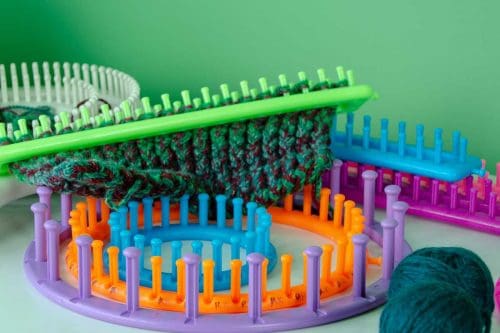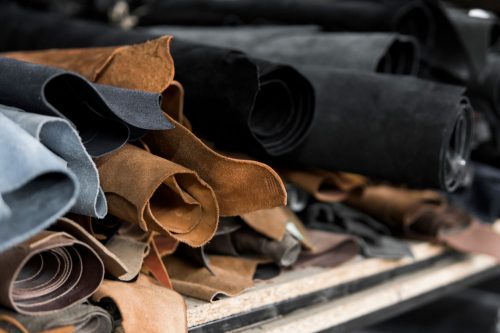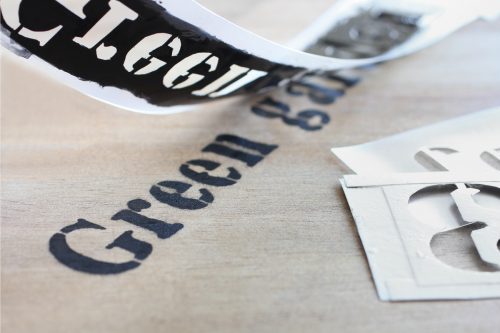Many people like the look of carved leather, but find the material too difficult or expensive to work with. If you are one of those people, you may be wondering if you can achieve the same effect on faux leather (also commonly called pleather). Both leatherworkers and crafters have agreed on the answer.
You can't truly carve faux leather, but you can create an effect similar to carving. Carving leather can obtain levels of shading and dimension that aren't possible on faux leather. However, you can decorate faux leather in the following ways:
- Engrave a flat design with a Cricut maker
- Hot stamp
- Emboss
If you still have more questions about faux leather and how to mimic leather carving, don't fret. In this guide, we'll discuss the different methods along with the similarities and differences between each style. So, without further ado, let's get to it!
![Craftsman emboss picture on leather using veiner tool, Can You Carve Faux Leather? [Here's how to create the effect]](https://craftsbliss.com/wp-content/uploads/2020/10/Can-You-Carve-Faux-Leather.jpg)
How To Mimic Carved Leather With Faux Leather
Engraving Faux Leather
Before we get started, there are a few things you'll need in order to engrave faux leather. First, you will need a Cricut Maker. Only certain models of this machine are capable of doing this job, such as the one below.
Click here to see this Cricut Maker on Amazon.
Additionally, you will also need the engraving tip for the Cricut.
Click here to view the engraving tip on Amazon.
Last, you will need Cricut faux leather. It's important to note that crafters who have tried this project have had mixed results if using other kinds of faux leather. Faux leather is actually just a fabric base, with an imitation leather finish. The actual materials used in both the base and finish can vary. So, one kind of faux leather may give good results, and another may work poorly.
Click here to view the Cricut leather sampler on Amazon.
Steps For Engraving With Your Cricut
- Move the white rollers to the side, away from where you will be placing your leather.
- Use transfer tape to stick the faux leather to the cutting mat.
- Smooth the faux leather to remove any air bubbles. There is a rolling tool (called a Brayer tool) with your Cricut for this purpose.
If you need more directions using your Cricut, this YouTube video is an excellent tutorial for making a leather/pleather engraved project:
Hot Stamping
While a bit tricky to master, some people have luck trying a hot stamp process. This requires more finesse than the Cricut and does need a heat source (as implied by the name). But it also may meet your needs with less specialized equipment, at a lower cost.
You'll either need a stamp or you can make your own. If making your own stamp, you will need a linoleum block like this one.
Click here to see more on Amazon.
Then pick your design and transfer it onto the block. Remember to pick something that is visually clean and easy to reproduce. A less complicated stamp transfers the best. Use your carving tool to carve out the design in the linoleum block. If you don't have a carving tool, try these Speedball linoleum cutters:
Click here to see more on Amazon.
If you need more negative space than you can carve, you can also try sanding the areas.
Once your stamp is done, you'll want to place the faux leather on the stamp face down. You can use an iron or (preferably) a heat gun like this one by Mofa:
Click here to see more on Amazon.
As the faux leather heats, you'll begin to see the imprint come out the backside of the material. This means you are done. Avoid overheating or pressing too hard so that it doesn't tear!
Embossing
Embossing is the least like carving, but also the easiest method listed here. Embossing does not actually try to penetrate faux leather in any way, so it is the best technique for thicker or more difficult pieces of fabric that do not respond well to the first 2 methods. It uses a special powder to create a raised effect on top of the fabric.
In order to emboss faux leather, you will need either a rubber stamp and embossing ink pad, or you can just use an embossing pen and the embossing ink pad to free-hand draw a design on the faux leather.
Click here to see this heat embossing ink bundle on Amazon.
You will also need embossing powder, and a heat gun like the one by Mofa listed above. You can use Wow! Embossing Powder, which is available in many colors.
Click here to see more on Amazon.
Steps For Embossing
- Press the rubber stamp into the ink pad (or use the pen and ink pad to draw your design). Make sure the stamp is coated completely with ink, then press firmly onto the faux leather.
- Apply the embossing powder to the wet ink (just sprinkle it on, nice and thick).
- Tap off the excess powder, but be careful to not smear the ink/powder combination.
- Plug your heat gun in and let it warm up for a couple of minutes, then heat up the embossing powder.
- Heat it for a few minutes, and you are all set!
Do You Need To Treat Faux Leather?
Now that you've made your project and have a beautiful piece of faux leather, the last thing you want is for it to start cracking and peeling. The best way to keep faux leather looking great is to regularly treat it with a special conditioner.
Baby oil is a common recommendation to condition your faux leather. Just apply a thin layer and rub it in. You can also buy leather conditioners such as TriNova Faux Leather Conditioner And Cleaner.
Click here to see more on Amazon.
As far as cleaning, you'll just want to use a warm damp cloth to wipe it off. If it's extra dirty or stained, you can use a little soap in the water. Then rinse all soap residue off with another clean damp cloth. Avoid being too rough by scrubbing or using a scratchy or abrasive cloth. Let it air dry, then use a conditioner to restore moisture.
How Do You Stop Faux Leather From Peeling?
If it's too late for cleaning and conditioning tips and your faux leather is already peeling, there's still a chance of saving it. Faux leather is designed to mimic the look of real leather, so many things that improve the look of real leather can also work on faux leather. Faux leather can be painted over, which can be particularly useful to stop it from peeling. You can see the process on this YouTube tutorial:
How Can You Paint Over Faux Leather?
You will need to use special acrylic leather paint. It is very important to use the correct paint. Acrylic paint is more flexible (which prevents it from cracking again in the future) than other paints. Acrylic leather paint is made from a special formula to adhere to faux (or real) leather. You may want to try this one by Angelus, available in a variety of colors:
Click here to see more on Amazon.
Does Faux Leather Tear Easily?
While faux leather doesn't necessarily tear easily, it does tear faster than real leather (which is more elastic than its artificial counterpart). Faux leather mimics the surface look of leather but lacks the natural collagen that gives natural leather its elasticity. This is also why faux leather peels sooner than real leather.
In Closing
Though faux leather cannot be carved the same way that real leather can, it can be decorated. Methods for decorating include engraving with a Cricut Maker, hot stamping, and embossing. These crafts can produce a pleasing aesthetic that resembles a simple carving.
Just be sure to take care of your faux leather project when you're done, as faux leather is not as resilient as real leather!
















